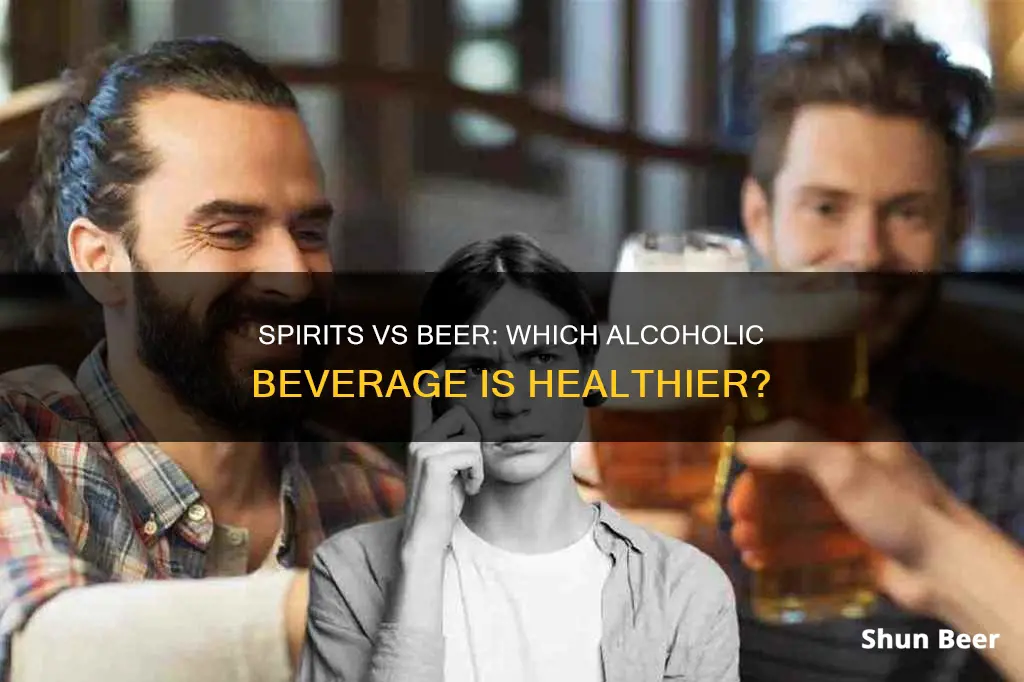
Alcohol is not a healthy choice, but some alcoholic drinks are better for you than others. Beer and spirits, or liquor, have similar health benefits, and drinking in moderation is key to reaping any benefits. Spirits have the advantage of often containing zero carbohydrates, but when mixed with sugary drinks, they can be loaded with calories. Beer, on the other hand, is easier to control calorically, and dark beer has more iron than pale or non-alcoholic beer.
What You'll Learn

Spirits have fewer or no carbohydrates
When it comes to low-carb alcohol, distilled spirits are the best option. They are almost entirely free of carbohydrates, so the only concern is what you mix them with. Vodka, rum, whiskey, gin, and tequila in their pure form have no carbohydrates, which is beneficial for keeping your blood sugar from spiking.
If you're watching your carbohydrate intake, you can still enjoy a drink. Spirits can be served as a single shot, with ice, or with a mixer. If you use a mixer that is naturally calorie- and carb-free, like still or sparkling water or club soda, you can make a completely carb-free drink.
However, other popular mixers like tonic water, ginger ale, cola, and lemon-lime soda can add calories and carbohydrates. If you're making a drink that's heavier on the mixer, such as a highball, use low-carb mixers to avoid adding extra carbs.
Beer, on the other hand, typically doesn't make it onto low-carb lists because most varieties are loaded with carbohydrates. A regular beer contains about 12 grams of carbs per serving, and the darker or heavier the beer, the more carbs it has. Beers with higher alcohol content have more calories and carbohydrates than less alcoholic beers.
So, if you're looking for a low-carb alcoholic beverage, spirits are a better option than beer.
Champagne vs Beer: Which is the Healthier Choice?
You may want to see also

Beer has more antioxidants
The antioxidants in beer are derived from both the malt and the hops, and the levels found will depend on the style of beer and the raw materials and brewing processes used. Beer contains more than twice as many antioxidants as white wine (of equivalent alcohol content) but only half the amount in red wine, although the antioxidants in beer tend to be smaller molecules than in wine and may be more readily absorbed by the body.
The main antioxidant compounds in beer are phenolic compounds and melanoidins. Phenols present in beer help lower blood pressure and increase the concentration of nitric oxide in the plasma, reducing the risk of cardiovascular disease. Xanthohumol, a flavonoid present in beer and found only in hops, has anti-cancer properties and is effective against different types of cancer, including breast, ovarian, and colon cancer.
In summary, beer has more antioxidants than spirits, and these antioxidants provide potential health benefits such as improved cardiovascular health and reduced risk of certain types of cancer. However, it is important to note that excessive alcohol consumption can lead to health issues, and moderation is key to reaping the potential benefits of antioxidants in beer.
Athletic Beers: Healthy or Just Hype?
You may want to see also

Spirits have a higher alcohol concentration
In comparison, beer typically has an alcohol content of between 4% and 6% ABV, with some beers having as low as 2% ABV. The higher alcohol concentration in spirits means that they can cause drunkenness and alcohol poisoning more quickly and in smaller doses than beer.
It is important to note that the effects of alcohol on the body depend on the amount consumed and the rate of consumption, rather than solely on the type of drink. Excessive alcohol consumption, regardless of the type of drink, can lead to liver damage, increased risk of certain cancers, and other negative health consequences. Therefore, moderation is key when it comes to alcohol consumption.
Porter Beers: Healthy or Unhealthy?
You may want to see also

Beer has more calories
Beer and spirits have very different calorie contents, with beer generally being the more caloric option. A typical 12-ounce beer has around 140 calories, which is similar to a can of Coke. The calorie content of beer depends mostly on its alcohol content and, to a lesser extent, its carbohydrate content. Regular beers with an alcohol content of around 5% can contain approximately 150 calories. Higher alcohol content beers, such as IPAs and Belgian-style Trippels, can contain 200 to 300 calories.
On the other hand, spirits like gin, rum, tequila, vodka, and whiskey provide around 100 to 120 calories per 1.5-ounce shot. This is because all of the calories in liquor come from alcohol, which has around 7 calories per gram. So, if you're looking to cut down on calories, opting for a shot of liquor instead of a beer might be a better choice.
It's worth noting that the way you drink your liquor also matters. When mixed with sugary sodas or juices, liquor takes on additional calories and carbohydrates. Similarly, draft beers served in larger glasses can contain up to 250 calories.
While beer may have more calories, it's important to remember that both beer and spirits have their unique health considerations. Beer, for example, contains phenolic compounds or antioxidants, mostly originating from barley malt. Spirits, on the other hand, often have fewer or no carbohydrates, which can be beneficial for those watching their blood sugar levels. Ultimately, moderation is key when it comes to reaping any potential health benefits from alcoholic beverages.
Cider vs Beer: Which is the Healthier Choice?
You may want to see also

Spirits are easier to over-pour
Spirits are often assumed to be stronger than beer, and while this is true in terms of alcohol content by volume, it's important to remember that the effects of alcohol are similar regardless of the drink. Beer and spirits can lead to the same drunken behaviours and negative health effects if consumed in excess.
When it comes to serving sizes, spirits are easier to over-pour than beer. A standard drink of spirits is 1.5 ounces, while a beer is typically 12 ounces. It's much easier to accidentally pour 3 ounces of spirits than it is to pour 24 ounces of beer. This is especially true when free-pouring, a technique where bartenders pour without using a jigger or measuring device. Free-pouring is a common practice and is often seen as more professional and entertaining. However, it can be less accurate and make it easier to over-serve customers.
To master the art of free-pouring, bartenders must practice counting while pouring into a jigger to establish a specific count for a specific amount. They then use this count to free-pour into a glass and check their accuracy with a jigger. While this technique can be learned by anyone with decent coordination, it does take time and practice to master, and beginners may struggle with accuracy.
In summary, while spirits may have a higher alcohol content than beer, it's important to remember that any type of alcoholic drink can lead to problems if consumed in excess. Spirits are easier to over-pour than beer due to the smaller serving sizes, and free-pouring techniques can further increase the risk of over-serving.
Stout Beer: Healthy Choice or Unhealthy Indulgence?
You may want to see also
Frequently asked questions
Spirits and beer have similar health benefits and drawbacks. Beer has more antioxidants than spirits, but their overall effect is small. On the other hand, spirits often have fewer or no carbohydrates.
Beer contains phenolic compounds or antioxidants, mostly from barley malt, which can have a positive effect on health.
Spirits, such as vodka, tequila and gin, are lower in sugar and calories and are easier for the body to metabolise.
Alcohol is toxic to the liver and prolonged abuse can lead to liver damage and even liver failure. Alcohol is also associated with an increased risk of certain cancers.







